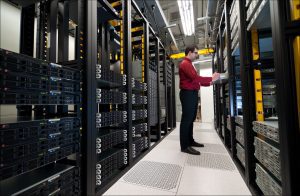If you run a small- to medium-sized data center, here’s a way you may be able to save about 20% on your cooling system energy bill: implement close-coupled cooling.
Close-coupled cooling, as the name suggests, involves placing cooling units close to the IT load they are intended to cool. With such a configuration, the air has to travel a shorter path as compared to room-based cooling systems that are traditionally installed around the perimeter of a data center, says John Niemann, Product Line Manager for Row and Small Systems Cooling with Schneider Electric.
I talked to Niemann about close-coupled cooling for a podcast for the Schneider Electric Data Center Blog. He went over some of the key criteria to consider when choosing a close-coupled cooling system, starting with the type of heat rejection the system uses. “Typically medium to large facilities, those deploying over 200Kw in load, deploy chilled water systems,” he says. “Smaller applications, under 200Kw, utilize compressorized refrigerant or direct expansion based systems.” The refrigerant systems also come into play for companies that are skittish about putting water-based systems so close to their IT equipment; a legitimate concern.
The other big consideration is form factor. “Most commonly, just because of the simplicity of installation, we see the air conditioners being placed right in the row adjacent to IT equipment, mounted on the floor just like you’d see an IT enclosure,” Niemann says. But in situations where space is an issue, there are units that can be placed overhead.
In terms of the features to look for in a close-coupled cooling system, Niemann cites three of them. The first is the ability to tightly control the temperature of the air the systems deliver. “You want a system than you can monitor and control based on the temperature the IT load is seeing,” he says. To minimize energy consumption, you don’t want the system over-cooling the space.
Another criteria is management capabilities, which includes visibility into actual cooling capacity in real time. The cooling system should be able to feed this data into an infrastructure management system so data center operators can determine where they can safely deploy IT loads based on available cooling capacity.
Finally, close-couple cooling systems should be modular, with the ability to scale as your IT loads grow. In that fashion, you can ensure you aren’t paying for cooling capacity before you really need it.
One best practice that Schneider recommends is to use containment systems with close-coupled cooling, specifically hot aisle. “Hot aisle containment provides the least impact, especially for an existing facility because it effectively captures the hot air, leaving the rest of the room unimpacted by the load that’s being cooled in that given zone,” Niemann says. (For more on containment systems, check out our previous podcast in this series.)
From his experience, close-coupled cooling systems deliver the best returns in terms of energy savings for small- and medium-sized data centers, where they can cut cooling system energy consumption by 20%. Factoring in the up-front costs of the systems, they usually pay for themselves in 3 years or less, he says.
To learn more about close-coupled cooling, click on the link at the top of this post to hear my entire conversation with John Niemann.




Conversation
I find that taking the time to validate the close coupled cooling options is a valuable step.
Today it is less of a space issue that face many clients but instead Data Center or Computer Room Cooling.
To better understand this issue you can find many references and resources like these:
https://www.ptsdcs.com/datacentercoolchallenge.asp
https://www.ashrae.org/resources–publications/bookstore/datacom-series